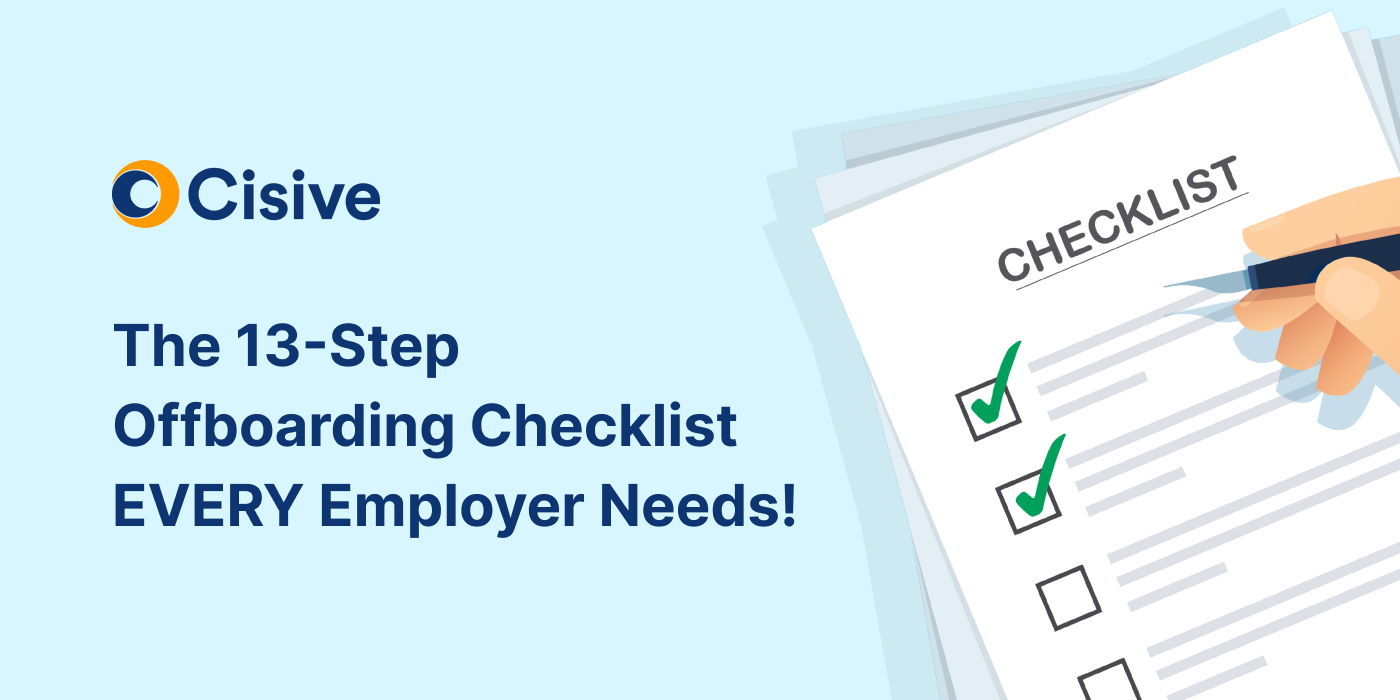

Recruiting and hiring remote employees on a global scale is challenging—even large enterprise...

The way an employee leaves your company is just as important as how they arrive. An effective employee offboarding checklist can help you streamline and structure the process to protect the company and support departing workers.
In this article, we’ll explore how offboarding impacts your business and review all the steps you need to transition an employee out of the company.
|
Employee offboarding is a process that helps departing workers transition out of your company, whether they’re retiring, resigning, completing a contract, or being terminated.
Structured offboarding benefits both your organization and the employee. It eliminates guesswork and creates a smooth experience for everyone involved.
From the company’s perspective, benefits of a structured offboarding include:
While offboarding might seem like a run-of-the-mill administrative process, it can have far-reaching effects on your reputation, recruitment, and retention.
When an employee leaves a job, they’re almost certain to discuss the experience with friends, professional contacts, and even social media followers. The quality of your offboarding process can directly influence what they say.
If you create a respectful and professional transition for everyone, regardless of their reason for leaving, they’re more likely to speak well of your company. These glowing reviews from former employees give your brand a positive reputation, which can improve hiring, recruiting, and partnership opportunities.
Departing employees aren’t the only ones impacted by offboarding—the rest of your team is watching, too. When they see that the company treats outgoing workers fairly, it can boost morale and improve your retention rate.
A smooth separation maintains strong relationships, increasing the likelihood that workers will return to the company as a consultant or a rehire. These “boomerang” employees can be valuable additions to your talent pool.
As you determine how to offboard employees, it’s helpful to develop a customized checklist. This useful tool standardizes and streamlines the process, ensuring that it’s both comprehensive and consistent.
At a minimum, your employee offboarding checklist should include the following 13 elements.
When a manager discovers that an employee is planning to leave, they should inform HR immediately. Early notification enables the HR team to conduct a structured and compliant offboarding process.
Once HR is aware of the pending departure, they typically acknowledge it in writing. Doing so establishes an official record and prevents future misunderstandings.
Cisive Exchange automates and streamlines this process. The HR acknowledgement is digital, eliminating paper documents and keeping everyone on the same page.
During this phase of offboarding, the employee submits a letter of resignation that formalizes their intention to leave the company. It creates a paper trail that helps ward off misunderstandings and prevents the employee from claiming they were terminated.
A resignation letter is critical for record-keeping, but it also provides a window into the employee’s state of mind. The contents can help you understand why the person is leaving and establish a basic departure timeline.
Review the departing employee’s records and verify that the information on file is correct. If not, request a current phone number, email address, and physical address.
Up-to-date information makes it easier to communicate with the employee during and after the transition. You’ll also be prepared to send references, final paychecks, and critical employment documentation.
While you’re gathering data, record a few additional facts: the duration of employment and future plans, for example. Over time, this information aids in identifying trends in employee tenure and turnover.
This step can be completely automated with Cisive Exchange and custom-configured to match your company’s specific requirements regarding data to be collected at this step.
When you manage employee offboarding with the Cisive platform, you’ll gain access to the Cisive Analytic Reporting Tool (CART). This business intelligence system captures information about the employee’s experience at every step of the process.
With CART, there’s no need to dig through documents to unearth relevant insights. Simply choose from a broad portfolio of reports to analyze offboarding data at a glance.
Over time, Cisive’s analytics help you spot patterns regarding employees’ reasons for leaving or feedback about company operations. With that information, you can address underlying issues that may be causing unwanted turnover.
Recommended Reading: Cisive’s Onboarding & Offboarding Solution
Once you have a written record of an employee’s plan to leave, it’s time to loop in the rest of the company.
Start by clearly communicating the departure to the relevant internal teams. Advance notice enables managers and coworkers to adjust their workflows and minimize disruptions.
Next, inform external stakeholders who will be affected by the departing employee’s absence; this might include clients, vendors, and partners. Transparent communication helps maintain trust and guarantees a smooth transition.
Departing employees take with them a great deal of institutional knowledge and wisdom. Before they leave, schedule knowledge transfer sessions.
Focus on recording information regarding:
By capturing as much information as possible, you can ensure project continuity, minimize disruptions, and ease the transition for all stakeholders. Consider using a variety of session formats, including knowledge transfer interviews, written notes, and job shadowing.
Provide departing employees with copies of all contracts, agreements, and policies connected with their position.
Ask an HR team member to hold an in-person review of any legally binding contracts that affect the employee after they leave the company. Highlight the importance of adhering to agreements related to non-disclosure, non-disparagement, intellectual property, cooling-off periods, and non-compete clauses.
If you operate in a highly regulated industry or work with sensitive information, Cisive’s background screening services can help you ensure compliance with the latest statutes and regulations.
Employees can create enormous digital footprints during their tenure at your company. To minimize security risks and protect confidential data, conduct a thorough review of each person’s digital assets.
Specific assets vary by business but typically include emails, digital files, and collaborative online projects. It’s also important to consider attachments in messages, documents stored locally, client contact information, and work-related voicemail messages.
Work with the employee to create an asset management plan that addresses any security concerns. Oversee the transfer or deletion of files to ensure that employees don’t inadvertently expose sensitive information.
Create a process to systematically revoke the departing employee’s access to company servers, software, databases, and digital platforms. Remember to include email accounts, collaboration platforms, SaaS subscriptions, and social media accounts.
This is the most complicated step of the employee offboarding checklist; you may be surprised to discover how many systems the company uses. Cisive’s technology can help you create a thorough and secure data-handling process that minimizes risks and ensures each account is deactivated promptly.
Sit down with the departing employee and explain their options regarding healthcare benefits and retirement plans. Depending on company policy and applicable state and federal laws, ongoing benefits could include severance pay, COBRA coverage, pay for unused sick days or vacation days, and access to retirement accounts.
An HR team member should communicate all relevant information and assist the employee in making informed decisions about their benefits.
Provide the employee with a list of company assets that must be turned in on or before their final day. Include items such as phones, laptops, tablets, chargers, keys, security badges, and ID cards.
If needed, refer to your onboarding records for a list of items that were issued during the employee’s first week. A thorough checklist minimizes financial losses and potential security risks.
End an employee’s tenure on a high note by hosting a farewell celebration in their honor. Use the event to thank the person, recognize their accomplishments, and wish them well in their future endeavors.
Quitting a job can be uncomfortable, even under the best of circumstances. A friendly send-off leaves a lasting positive impression on the departing employee and strengthens company culture.
Let the employee know when they’ll receive their last paycheck. If your state regulates the timeframe for final wages, explain the relevant laws and how they apply to the situation.
Before the person leaves, communicate clearly about what the check will include. Break down deductions and additions, such as bonuses, benefits, or incentive payouts.
After the paycheck is issued, double-check the information to make sure the employee receives all due payments.
With Cisive, you can design a robust, structured offboarding process that’s tailored to your company’s business workflows and HR requirements. It all begins with Cisive’s comprehensive background screening solutions, which are designed to ensure compliance in highly regulated industries.
To help you stay informed and compliant, Cisive continually monitors and interprets all proposed and active regulations and statutes that impact your offboarding activities. The system also tracks enforcement actions, orders, and sanctions across a range of industries and regulatory bodies.
Offboarding can be complicated for the HR department and outgoing employees. Cisive brings order and convenience to the process, creating a streamlined experience for all parties.
The customizable digital platform walks employees through each step, keeping them informed and supported at all times. There’s no need to keep track of paper documentation—workers can log in from any internet-connected device and use the mobile document app to upload resignation letters and other forms.
To save time, Cisive automates common offboarding processes. The built-in analytics tool collects and analyzes critical data to help decision-makers understand overarching trends in employment and turnover.
At Cisive, every decision is driven by a commitment to legal compliance. The proof is in our impeccable track record; we’re proud to report that we have never had a data breach or a class-action lawsuit.
Employee turnover is inevitable in every industry. With a well-structured, legally compliant offboarding process, you can maintain a positive relationship with departing employees and reduce security risks to the company.
As you standardize the process, consider leveraging Cisive’s comprehensive technology to create a smooth, secure, and compliant offboarding experience.
Cisive Exchange moves your offboarding process onto a secure digital platform, increasing access and transparency for employees and the HR team. It automates each step to ensure a smooth and structured experience.
Since the process is online and completely digital, the off-boarding events can be done without an employee ever visiting an office, an important consideration given the percentage of the workforce that is currently working from home.
With Cisive, it’s easy to track and secure key offboarding activities, such as data transfer, digital asset management, and organizational access. The system scans laws and regulations to help you stay compliant and monitors criminal activity among former employees to mitigate security risks.
To ensure that your offboarding practice is compliant with industry regulations, focus on managing access to sensitive information. Review confidentiality policies, conduct a thorough review of digital assets, ensure the return of company property, and revoke access to company systems.
A respectful and transparent offboarding strategy can help your company maintain strong relationships, even under difficult circumstances. It’s also important to ensure that the outgoing employee is fully informed and fairly compensated in terms of both pay and benefits. Speak with a Cisive expert today to learn how you can streamline your offboarding process!

Recruiting and hiring remote employees on a global scale is challenging—even large enterprise...

In transportation, there are four reports that most employers will request when reviewing...

Employers that use background screening methods to vet potential employees are likely aware of...